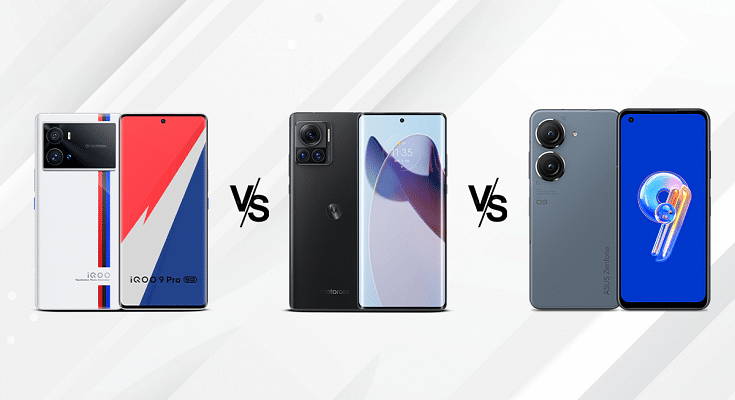The flagship smartphone industry is getting ramped up with the launch of powerful Android smartphones from some of the popular brands. Motorola recently ramped its game in the premium smartphone market with the Moto Edge 30 Ultra which is the world’s first 200MP camera phone. Motorola isn’t just elevating the camera experience with the Edge 30 Ultra but also the overall user experience by equipping it with top-tier hardware.
The Motorola Edge 30 Ultra has joined the list of a few Snapdragon 8+ Gen 1 chipset-powered phones in the country. Amongst the previously introduced models are the iQOO 9T and the Asus ZenFone 9 both of which are also driven by Qualcomm’s new-age flagship Snapdragon 8+ Gen 1 processors. If you are confused about which out of three models makes for the best buy, this spec-sheet-based comparison will help you decide.
iQOO 9T Vs Motorola Edge 30 Ultra Vs Asus ZenFone 9: Display Specifications
Starting with the iQOO 9T, the flagship gaming handset has been launched with a massive 6.67-inch display, which is an AMOLED panel with an FHD+ resolution of 1080 x 2400 pixels. The screen on the iQOO 9T further supports HDR10+ certification and has 1500 nits peak brightness levels which allow for good visibility under direct sunlight. It has a 120Hz refresh rate for a fluid touch response. The panel on this iQOO phone is protected by a Corning Gorilla Glass 5 protection.
Motorola has released the Moto Edge 30 Ultra with an OLED display which is also tall and measures 6.67-inches. The Motorola Edge 30 Ultra’s screen also offers 1080 x 2400 pixels FHD+ screen resolution and has a standard 20:9 aspect ratio. The screen on the Moto Edge 30 Ultra supports a higher 144Hz refresh rate which is best suited for gaming visuals. The display on the Edge 30 Ultra has 1250 nits peak brightness which is lower than the iQOO 9T. However, the sunlight visibility is still good with this phone.
Asus has used a Super AMOLED screen on the ZenFone 9 that supports the same 1080 x 2400 pixels FHD+ resolution and 20:9 aspect ratio. The refresh rate on this phone is equal to the iQOO 9T, i.e., 120Hz. However, the ZenFone 9 has the smallest screen size out of all models on this list. It features a 5.9-inch display that is protected by Corning Gorilla Glass. The iQOO 9T has the brightest panel, while the Motorola Edge 30 Ultra has the highest refresh rate.
iQOO 9T Vs Motorola Edge 30 Ultra Vs Asus ZenFone 9: Camera Specifications
If you are looking for the best-in-class camera hardware, the Motorola Edge 30 Ultra with a 200MP triple rear camera is the best option. The flagship Moto handset’s main camera (200MP) combines a 12MP telephoto lens and a 50MP ultrawide sensor. The triple rear camera module on the Motorola Edge 30 Ultra can not only capture detailed daylight but also night images. The camera setup on the premium Motorola phone has up to 8K@30fps video recording support and has a bunch of shooting modes for an enhanced camera experience.
The iQOO 9T also ships with a triple rear camera setup where the primary lens is a 50MP sensor with an f/1.9 aperture. The iQOO 9T additionally features a 12MP secondary telephoto lens with an f/2.7 aperture and 2x optical zoom support and a 13MP ultrawide sensor with 120-degree FoV. This phone offers up to 4K@30fps video recording.
The Asus ZenFone 9 also ships with a 50MP main camera that has an f/1.9 aperture with gimbal OIS support. It is aided by a 12MP ultrawide camera that has a 113-degree FoV. In the selfie camera race as well, the Motorola Edge 30 Ultra takes the lead with the 60MP selfie snapper. The iQOO 9T and the Asus ZenFone 9 offers a 16MP and a 12MP selfie camera respectively.
iQOO 9T Vs Motorola Edge 30 Ultra Vs Asus ZenFone 9: Chipset, Battery, Fast Charging Comparison
Under the hood, all these three phones, i.e., the iQOO 9T, Motorola Edge 30 Ultra, and the Asus ZenFone 9 use the latest generation Qualcomm premium chipset – the Snapdragon 8+ Gen 1 chipset. Fabricated using an ultra-thin 4nm process, the Snapdragon 8+ Gen 1 chipset makes sure power delivery is ample for basic as well as extensive tasks. The chipset further is integrated with Adreno 730 GPU. All three phones are launched with Android 12 OS and feature a custom user interface.
Both iQOO 9T and the Motorola Edge 30 Ultra offers up to 12GB RAM capacity, while the Asus ZenFone 9 comes with up to 16GB RAM option. As for the storage capacity, its 256GB with the iQOO 9T and the Asus ZenFone 9 and up to 512GB with the Motorola Edge 30 Ultra.
Speaking of the battery capacity and fast charging technology, the iQOO 9T ships with a 4,700 mAh battery unit with 120W fast charging, whereas the Motorola Edge 30 Ultra features a 4,610 mAh battery with 125W fast charging technology. Rounding off the Asus ZenFone 9’s spec-sheet is a compact 4,300 mAh battery with 30W fast charging technology.
